Handling your truck on country roads
It's time again for a truck accessories article. We all want a truck to go 300,000 miles and we think we'll live forever. When I sold trucks, I was surprised at how many folks had accidents in their trucks and unhurt, they came back to me to buy another truck! Trucks are safer than cars, don't let anybody fool you. I'm looking for ways and products to keep trucks and trailers safer. Growing up in the country and driving on gravel roads most of my life, gave me a unique way of evaluating how trucks and the accessories perform on dirt roads as well as the asphalt. These two products will make a big difference in the way your truck handles.

Correctrack rear-wheel alignment system can save lives and dramatically improve how your truck, van or SUV handles on gravel roads and pavement.
After I spent a couple of weeks driving GM Quadrasteers and enjoying the stability with a trailer and on snowy icy roads, I dawned on me that part of the equation was the wider rear track of the Quadrasteer. A normal GM HD 2500 4x4 has the same rear axle as a 4x2 for obvious economic reasons. So the 4x4 rear axle is 2 inches narrower than the front. But the Quadrasteer rear axle is over 3 inches wider than the front axle. This reminded me of reading about Correctrack rear-wheel alignment system. Now I'm testing the spacers. There are several makes of trucks and vans that have this front to rear tracking deficit.
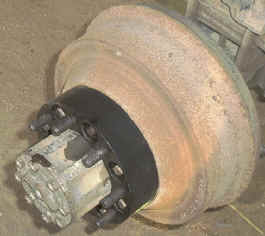
Pot holes, gravel ruts and washboards will test the handling characteristics of a truck. Test driving the GM Quadrasteer opened my eyes to what a difference a wider rear axle could do. The majority of HD GM's have a narrow rear axle. Ford HD trucks were narrower through 97 and Dodge trucks older yet. The majority of Ford, Dodge and older GM vans have narrower rear axles. I doubt if this inconsistent axle alignment is by a master engineering design but more of a money saving measure to use the same rear axle on 4x2's and 4x4's. This is something you really have to experience to appreciate the difference.
I went out to ranch that a friend owns, (yes I still have a friend or two) and tested out the Correctrack rear-wheel alignment system in the rugged wild west. The test truck was a 1997 Ford 4x4 F250 crew cab diesel. The rear axle on this Heavy Duty Ford F250 was almost 3 inches narrower than the front axle. That surprised me!
|
|
I've driven a few million miles on gravel roads, and I consider them the most dangerous type of surface. Dirt roads constantly change, with rain, snow, ruts, washboards, and gravel ribbons, it all can be different any day. The soft shoulder is always a danger trying to suck you down the ditch. The better handling your truck is, the more control you have for those ever changing conditions. You can feel the extra pull the ruts and gravel windrows put to your trucks steering and the bounce the washboards cause the rear axle of an empty truck.
It was very simple and easy adding the Correctrack spacers. Once the spacers and wheels were torqued down, we were ready for the test. I watched the rear wheel tracking in the yard on the way to the road and looked like a match. Going down the same dirt roads, that I took before we added Correctrack, you could immediately tell the difference! The ruts didn't pull you and the washboard didn't make the back axle jump from side to side.
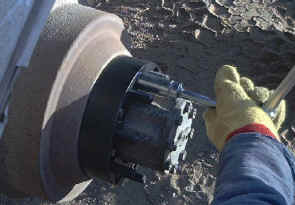
Turning corners was even different with less rear sliding. The truck was just easier to drive with less movement from the steering wheel, do to road feedback. And with a trailer on the truck you could feel the better control with less over steer to drive straight. I wouldn't of thought that I would see such a dramatic change in the effort it takes to handle the truck with the spacers added. Don't forget the pavement, you still have washboards, semi truck ruts, pot-holes and the cargo that falls out of the back of someone else's truck you're following. Evasive maneuvers can happen at anytime and you want a rear axle wide enough to help you control the fishtailing and leaning on turns. There is a reason sports cars, such as a Chevy Corvette, and stock cars have wider rear tires. It's all about control.
Basically a rear axle that is narrower than the front axle doesn't even sound logical. Do you suppose it's a cheaper way to build trucks? Would you special order a truck that way on purpose? The older Heavy Duty Fords, 97 4x4 and back can have this problem, older Dodge trucks heavy duty 4x4 and most of the GM 4x4 Light Duty 2500 and Heavy Duty 2500 still today have a narrower rear axle tracking. Also GM 2500 4x4 Suburbans and Yukon XL's can have a narrower rear axle. GM did solve it with the newer full size vans. New Ford and Dodge vans today still have a narrower rear axle on the heavy duty vans your church and school use. It's easy to figure out, just go measure your truck and van to see if the rear is narrower.
The question you might have with such a well built heavy duty alignment spacer, is will this cause strain to the rear axle bearings. The Correctrack spacer kit has completed a Daimler Chrysler K-1 durability test and warrants the rear axle bearings to 100,000 original miles. Know of any truck manufacture that does that? Call Correctrack Inc. for warranty details.
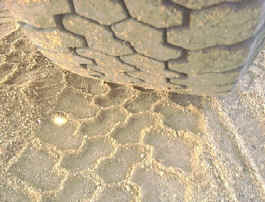
Measure your truck or van axles to see if it's tracking or constantly making new tracks. Do you suppose following the same track will help fuel mileage? If you want an edge on safety for your truck and trailer handling, this is something to try. You can even send them back if you don't like them. No risk, I like it! Correctrack Rear-Wheel Alignment System.
We're adding the Correctrack to a new GMC HD 2500 next, stay tuned.
Next, Centramatic Wheel Balancers
While we were testing the Correctrack spacers, we added Centramatic wheel balancers on the front tires. The test truck again was a 1997 Ford F250 crew cab diesel. With diesels being so popular in the 3/4 ton trucks and larger, the extra weight from a diesel engine keeps your front tires working. The tires had 10,424 miles on them. And as most of these 10 ply E rated 16 inch tires do after a few miles, you can feel the vibration in the steering wheel and notice the extra effort it takes to steer through the gravel ribbons in the road. And that's how this truck felt with 10,000 miles on the tires. We added the Centramatic balancers and you guessed it, the vibrations gone and it steered better. That vibration at the steering wheel does get irritating doesn't it?
Beside reducing your tire heat by 8 to10% and increasing tire life by 25 to 50%, according to Centramatic, the design also helps reduce brake heat and brake dust that transfers to the tires and wheels. These "On Board" balancers will keep your tires balanced automatically as your drive on your truck and trailer.
It's hard to keep a tire balanced on the rough roads that a lot of trucks live on. So just after a few months of driving, your tires don't fill new anymore. And then there is the cupping that the front tires like to do.
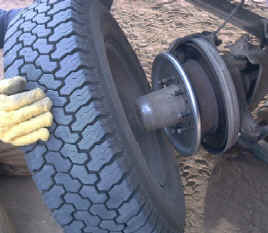
Pot holes, gravel ruts and washboards constantly beat on your tires. The heavy duty tires on your trucks and trailers have a deep thick sidewall that takes the first impact from the road surface. These thick tires are dramatically harder to keep balanced than a car tire considering the weight they carry and abuse dished out. I know several folks who just gave up trying to keep the trailer tires balanced. Why not have your tires automatically balance as your drive.
I'm going to test these balancers on high mileage horse trailers that travel across the country daily, for a long term test next.
GET THE FULL LIFE OUT OF YOUR TIRES
Patented Centramatic Balancers are a unique line of "On Board" Balancing Systems for tires and wheels that maximize tire life and smooth your ride. Mounted behind the wheel they offer permanent solutions for balancing assemblies. Centramatic Balancers operate automatically and can adjust instantly for changing conditions. Even with mud or ice packed on your wheels, you will have a vibration free ride.
Centramatics are available for Trucks, Tractor/Semi Trailers, Coaches, Buses, Delivery Vehicles, Motor homes, Trailers, Large Pickups, Jeeps and Police Cars. They even custom build for application-specific centrifuges.
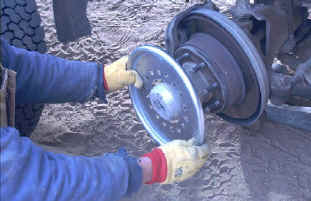
They are easy to install. Add them to your truck and trailer and have that "just new" ride again!
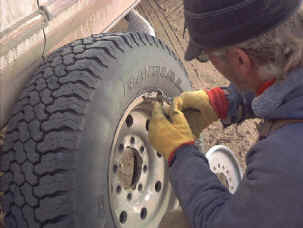
How long do you think those lead weights will keep that heavy 10 ply tire bouncing down those ruts and pot holes in balance? Come on guess!
Centramatic has been in business in Ft. Worth Texas since 1985 and holds over 10 patents in "ON-BOARD" balancers. They come with a 5-year unlimited mile warranty, and they offer a no-risk money back guarantee.
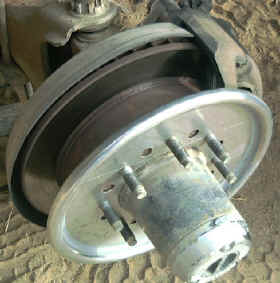
These balancer discs will also protect your tires from brake dust and brake heat. Whether you are driving highways or those rough gravel roads. You will be able to tell the difference in handling and driving fatigue.
By adding these two easy to ad products to your truck, Correctrack Rear-Wheel Alignment System and Centramatic Wheel Balancers, handling and safety will be noticeably improved. We all need an edge dealing with road surfaces we can't control. |
Stop by my website and visit sometime
www.mrtruck.net. Kent Sundling (MrTruck)
© Copyright 2002 H. Kent Sundling and MrTruck.net. All rights reserved including digital rights.
Till next time, Good Truck'n.
Kent Sundling (MrTruck)
http://www.mrtruck.net
See more articles from Mr. Truck








